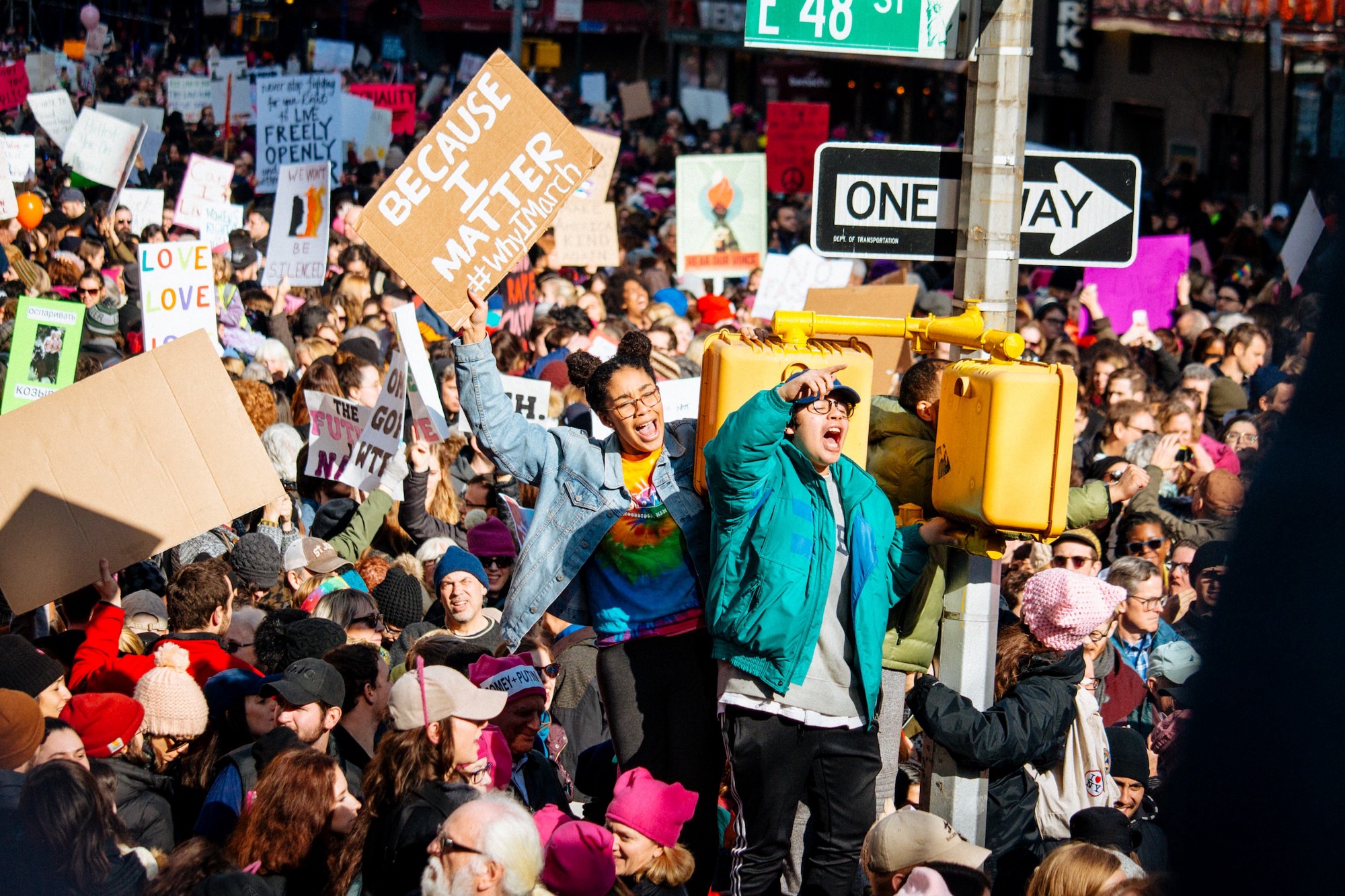“We have been far too absent from how our country is run”, interview with Patricia Jerido
by Bart Cosijn

Women’s March on New York City, photo by Mathias Wasik (CC BY-SA 2.0)
For our democracies to survive, we need people who want to be involved with how our communities are run. If we leave decision-making just to our representatives, or if we do not vote at all, we might weaken our democracies up to a point that they collapse. Out of concern for how few inhabitants of my city Amsterdam use their voting rights, I initiated the first Citizens’ Assembly (Burgertop Amsterdam) in 2015.
Before and after this inspiring gathering in June 2015 I spoke to many people who share similar concerns about the state of our democracies as I do. Many of them have strong ideas on how to renew local and national representative democracy. Although the directions in which they elaborate their ideas are very different. For example, people supporting ideas around the notion of deliberative democracy, advocate that taking decisions in a community could best be based on mutual discussion and a strive for consensus. Defenders of direct democracy believe that policy initiatives should be decided by the people, e.g. by voting. Both approaches aim for a greater involvement of people in decision- and policy-making, but their favoured instruments differ.
Referendum versus people’s assembly
This presents us with a dilemma: which direction should we follow? Deliberative methods like citizens’ assemblies or participatory budgeting are often considered to be instruments that are more likely to be supported by progressive politicians. Whereas referendums or popular juries are tools favoured by conservatives. But if you look more closely, this distinction is less easy to make. An aspect that plays a role is what you could describe as the dramatic aspect of democracy. A referendum often narrows down a very complex issue to a ‘yes’ or ‘no’ question. The electorate is forced to take a side. The third option is refusing to vote at all. Campaigns run and tensions are rising. And then the highlight comes with the result. Deciding by mutual discussion, in smaller and bigger groups, sometimes over a long period of time, often provides less fireworks and less dramatic elements that could be covered by media.
Iceland, Belgium and The Netherlands
In search for answers I wanted to speak to people who decided to become active against the backdrop of communities in crisis. My first stop was Iceland. After the country went bankrupted during the global economic crisis of 2008, many inhabitants felt the land of volcanoes and ice was morally bankrupt. Weekly protests in front of the Icelandic parliament fuelled a grass-roots movement that initiated a process of collective writing of a new constitution. Next, I turned to my neighbouring country, Belgium. When the political parties failed to form a new government during one year of negotiations, a group of engaged residents, led by the Belgian writer David Van Reybrouck, organised a nation-wide citizens’ assembly in Brussels in 2011.
In both countries, many people were motivated to come together and bring about necessary change that their representatives could not bring about. But the results were different than the people had hoped. The proposal for a new Icelandic constitution is collecting dust in a drawer of the parliament. And although the results of the Belgian G1000 Assembly was accepted by the chairs of parliament, they did not lead to any substantial policy changes.
Since 2014 in the Netherlands, inspired by the G1000 in Brussels, more than fifteen cities have organised citizens assemblies. I have tried to visit as many of them as I could in order to observe and learn from this process. As I did with debates organised around the first corrective referendum in 2016, requested by citizens, which challenged the Dutch law backing the treaty between the European Union and Ukraine. Roughly one third of voters showed up and almost two third of them spoke out against the law. The Dutch government decided to put the outcome aside. Something the leaders of the United Kingdom felt they could not do, after 51,9 percent of the electorate voted for a Brexit; the UK leaving the EU.
I couldn’t believe my eyes, when I learned about what had happened across the North Sea, as I woke up in a Maastricht hotel. I had been following the BBC live coverage on the referendum until I fell asleep in the early morning. The assemblies that I had researched and the one I initiated myself were far from perfect as democratic instruments, but deciding upon such an important membership of a country, by such a small margin in a referendum was a plain disaster.
New York City
I needed a broader picture. In the beginning of this year I got a chance to cross the Atlantic and visit New York for the first time in my life. I landed amidst the biggest democratic turmoil that I had ever experienced — one week after Trump was sworn in as the new president of the United States of America. My plan was to interview people and visit public gatherings, like assemblies, rallies, meet-ups and protests. I wanted to find answers to three questions: Which alternatives do people see for the heavily criticised American two-party system? How and where do people meet to discuss these alternatives? And how do their initiators reach out to larger and more diverse audiences?
I stayed with my nephew and his partner in Brooklyn, who were great hosts. They were both scared and angry by what was happening. As they went out to protest, I explored the city, looking for events and debates. With the help of friends I had the change to interview some inspiring people who provided me with insights to what was happening in New York and lead to bits and peaces of answers.
One of the people I met was Patricia Jerido, an expert on participatory budgeting and a truly inspiring woman. She is a member of the New York City Steering Committee for Participatory Budgeting, and a member of the Participatory Budgeting District Committee, in her own district 39 in Brooklyn. Before starting her own consulting business, she worked for a wide range of non-profits. Besides she also chairs the Board of Directors of the Center for Artistic Activism.
Participatory budgeting is a relatively new practise in New York, in which citizens have direct decision power over a part of the city’s funds. She took time to explain to me how it works in practice, but the most important insight she gave me was that the core problem lies not so much in the exact form of democracy we believe in, but in the huge lack of involvement.
It is nearly a year later. I had planned to publish this interview with Jerido earlier, but it got delayed by the birth of my son. In between changing nappies and enjoying Christmas dinners I finally managed to take time to write this intro to the original article, that I am happy to share with you hereafter.
Read the full article on Medium.com
